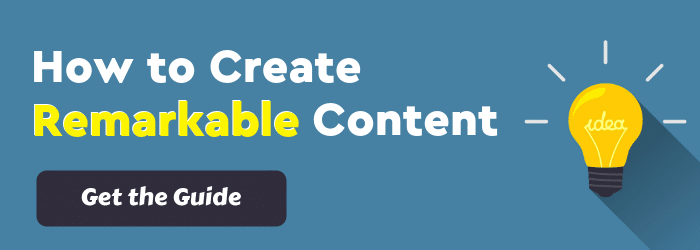
Seventy-one percent of B2B content marketers say they use case studies as a marketing tool. Like any other form of content marketing, if lots of people are seeing the value in this type of content, your case study has to be remarkable to stand out. And if you are going to cash in your chips with a client by asking them to help you with a project, there’s no point in only doing an average job. So, what do you really need to do to create a case study that is better than the rest?
I don’t know about you, but I think the facts can be pretty boring if someone doesn’t put some effort into making a creative presentation (and I don’t mean just graphically). Here are three critical questions you should ask yourself when you are assembling your next case study, and a list of answers to guide you in the right direction. Check off everything on this list, and you’re on your way to a remarkable case study.
What does this case study need to accomplish?
This is a big question, right? But it’s an important one, and as I mentioned earlier, the answer is not just to present the facts about what you did for Client X. There are some very specific jobs that the case study needs to perform for you. If you don’t tick off all the boxes on this list, the jobs won’t get done.
Tell a story—If what you present is very factual, maybe people will read it. But if you really tell a story, the likelihood that readers will stick with you goes way up. Find a case that has a compelling story—you know that some are better than others. Choose wisely. Like any good piece of content, you need a beginning, a middle and an end. Make your reader want to find out what happens next. Don’t give away all the good stuff right away, save the stellar results for your big finish.
Relate to the reader—Not every reader will relate to every case, but the key is to connect with your ideal customer. Those who can see their problem in your case study will be hoping that your genius can solve their issue, as well. If you have more than one target customer/audience, create several types of case studies.
Use facts instead of marketing hype—This one is pretty easy. Tell the story, show the facts, use real (not inflated) metrics for your project, and you don’t need to sell or use marketing hype. The facts will speak for themselves.
Shorten the sales cycle—Buyers are more than half way into their buying decision before they even want to talk to you or a sales rep, so they are looking for all the education and research they can find. Provide it and your case study will generate great leads for you. It can also help close a sale. Two weeks ago one of our clients was able to send a prospect a just-finished case study after it was specifically requested above all other marketing materials. It propelled them into the final round of discussions.
What belongs in my case study?
If your case study needs to accomplish everything I listed above, the next question you’re probably asking is: “How do I do that?” Here are some answers. There are lots of ways that you can create a case study—people use all kinds of different formats—but you should definitely address the following areas:
Headline—This is just as important in your case study as in your blog post or any other piece of content. It’s what draws people in or makes them wonder if they should read. Treat it like a newspaper headline. For instance, “How Company X Doubled Sales With a Content Marketing Overhaul” is more powerful than “Company X: A Case Study.”
Images/Visuals—This piece of content is not meant to be a sea of gray. Include your company logo, a screen shot of design work you did, or a graph featuring results information.
Design/format—Get someone to design your case study so that it reflects your company branding and looks professional. The format of your case study also needs to work for your audience. For some audiences, a text-based format is better. Others will be more receptive to something like an infographic or even a video. If you go with text, break it up with sidebars, boxes, bolded text or bullets so that, mixed with your images and visuals from above, you have something that is inviting to read.
The Situation—Offer an overview of the situation at the time that you were asked to step in and help. It should be the facts, without any opinion of the desolate nature of things as you found them. Usually the need for help speaks to people who are also looking for help.
The Challenge—Present the challenges and include anything that your client specifically asked you to tackle as part of the project.
The Work/Solution—Here’s where you show what you did and how you solved the problem. You want to include specifics in this section. What strategy did you use to get results? What are some of the tactics you executed? Offer details for what you did so your potential customers can see what they might get if they sign on with you.
Results—Choose a case study that has compelling results. Show as much in the way of metrics, KPIs, and ROI as possible. But remember that some results will be concrete, and some will be more focused on brand awareness. A quote from the client about how results affected their business will help. This can be more powerful than any metrics.
Client Quotes—While on the subject, make sure you get a few client quotes—good ones. You can sprinkle them throughout your text (like in “Results”), but a good design will also allow for one or more to be blown up as a pullout quote so that it jumps out at the reader.
Where can it go wrong?
There are potential pitfalls everywhere in content creation. Here are a few things you shouldn’t do with your case study.
Let it get stale—Don’t let your case study get outdated. If you have new information you can add or dates or statistics to refresh, do it. If readers believe your material is old, they become dubious that the story is still relevant.
Poor quality writing—The writing is every bit as important as all the things I mentioned above. Make sure your case study is well written, error free and adheres to the same remarkable standards that you use for all of your other content. It can’t be sloppy or bland.
Hide it—If you do all the work to make a great case study and then no one can find it, why bother at all? Make it easy to locate on your website. And when you have a new one, announce it.
Producing an average case study is pretty easy, assuming you’ve done good work for good clients. Average case studies are boring, though. Turn your case studies into business success stories chock full of the intimate details, house them prominently on your home page or “About Us” section, and now you’re onto something.
Have any good case study tips I missed? Let me know in the comments. For more information on creating remarkable content for your business, download our eBook, “How to Grow Your Business with Content Marketing.”



